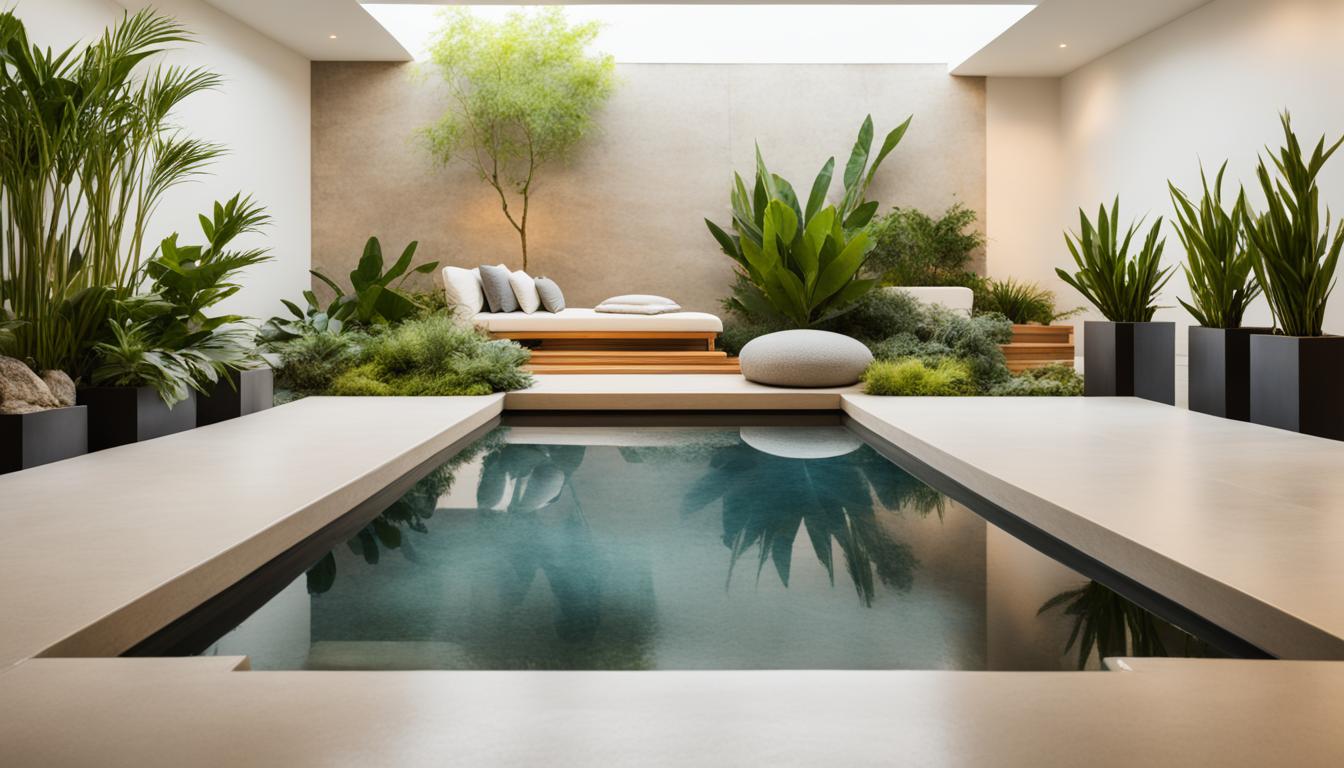As someone who has spent a decade loving a woman with chronic illnesses like endometriosis and fibromyalgia, I understand the challenges and the impact it can have on your life. This journey has not only shaped me into the man I am today, but it has also sparked a passion for creating a restful and healing home environment. Through my experience, I have discovered the therapeutic power of blogging, which allows me to escape the new normal, advocate for my ill partner, and secure our future financially.
The Benefits of a Healing Space
Creating a healing space in your home offers a wide range of benefits for your overall well-being. Studies have shown that our surroundings have a direct impact on our health, and by intentionally designing a healing space, you can experience reduced stress, improved health and well-being, and a greater sense of peace.
Evidence-based design and healing principles provide a framework for making changes to your home environment that support healing. By incorporating these principles into your space, you can create a nurturing and rejuvenating atmosphere that promotes relaxation and fosters overall wellness.
Here are some key benefits of having a healing space:
- Stress Reduction: A healing space provides a sanctuary where you can escape from the pressures of daily life and unwind. It offers a calm and peaceful environment that helps reduce stress levels and promotes relaxation.
- Improved Health and Well-being: By creating a healing space, you invite positive energy and promote a healthier lifestyle. The soothing ambiance can aid in lowering blood pressure, improving sleep quality, and boosting your overall physical and mental well-being.
- Sense of Peace: A healing space allows you to disconnect from the chaos of the outside world and find inner peace. It offers a refuge where you can replenish your energy, find solace, and cultivate a sense of balance.
Whether it’s a dedicated room or a designated area within your home, your healing space should be designed with intention and purpose. By incorporating elements such as natural light, calming colors, comfortable furnishings, and soothing scents, you can create a space that promotes relaxation, restoration, and healing.
| Benefits of a Healing Space | Description |
|---|---|
| Stress Reduction | A healing space provides a sanctuary where you can escape from the pressures of daily life and unwind. It offers a calm and peaceful environment that helps reduce stress levels and promotes relaxation. |
| Improved Health and Well-being | By creating a healing space, you invite positive energy and promote a healthier lifestyle. The soothing ambiance can aid in lowering blood pressure, improving sleep quality, and boosting your overall physical and mental well-being. |
| Sense of Peace | A healing space allows you to disconnect from the chaos of the outside world and find inner peace. It offers a refuge where you can replenish your energy, find solace, and cultivate a sense of balance. |
Investing time and effort into creating a healing space within your home is a valuable step towards enhancing your overall quality of life. By transforming your environment with evidence-based design and healing principles, you can create a sanctuary that supports your well-being and encourages a deeper connection to yourself.
Surround Yourself with Nature
Surrounding yourself with nature in your home can have numerous health benefits. It creates a sense of calm and connection to the natural world. There are several ways to incorporate nature into your home environment:
- Maximize natural light: Allow as much natural light as possible into your living spaces. Natural light not only brightens up the space but also boosts your mood and energy levels.
- Incorporate views of nature: Position your furniture to take advantage of any beautiful views you have outside your windows. This allows you to enjoy the beauty of nature even when inside.
- Add artwork depicting natural scenes: Hang artwork that showcases natural landscapes, flora, or fauna. This brings a touch of nature indoors and creates a soothing visual experience.
- Bring in flowers and house plants: Fill your home with the freshness of flowers and house plants. They not only add beauty but also improve air quality and create a sense of tranquility.
By incorporating these elements, you can create a harmonious and restful environment that brings the beauty of nature into your daily life.
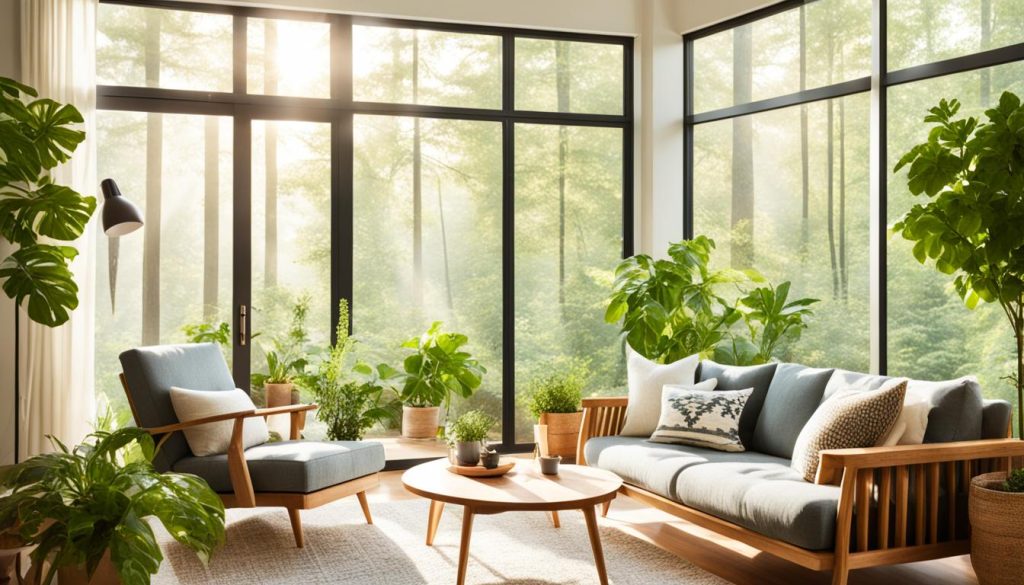
| Benefits of Nature in the Home | |
|---|---|
| Natural Light | Boosts mood and energy levels |
| Views of Nature | Creates a sense of connection and tranquility |
| Artwork Depicting Natural Scenes | Brings the beauty of nature indoors |
| Flowers and House Plants | Improves air quality and adds a touch of tranquility |
Decorate with Meaning
When creating a restful and healing home environment, it’s important to surround yourself with decor that holds personal meaning. By incorporating meaningful elements into your space, such as family photographs, religious symbols, meaningful objects, and artwork, you can create a sense of connection, comfort, and inspiration.
Family photographs are not just images on a wall, but reminders of cherished memories and loved ones. Display them in prominent areas of your home to evoke feelings of warmth and nostalgia. Whether it’s a wedding photo, a candid snapshot, or a generational family portrait, these images can instantly uplift your spirits and bring a sense of joy to your space.
Religious symbols can provide a source of strength, hope, and guidance. Whether you practice a specific faith or simply resonate with certain symbols, incorporating them into your decor can create a deeper sense of meaning and spirituality within your home. Hang a cross, place a Buddha statue, or display a prayer flag as a visual representation of your beliefs.
Meaningful objects, such as heirlooms or items acquired during significant life events, can also add a personal touch to your home. These objects hold sentimental value and serve as reminders of important milestones or loved ones who have passed. Whether it’s a piece of jewelry, a treasured book, or a special memento, these objects can bring comfort and evoke positive emotions.
Artwork is another powerful way to decorate with meaning. Choose pieces that resonate with you on a deep level, whether they depict scenes from nature, abstract designs, or thought-provoking illustrations. Art has the ability to evoke emotions, spark creativity, and serve as a visual representation of your personality and values.
When arranging your furniture, consider creating a space that encourages interaction and conversation. Position seating areas in a way that allows for easy communication and connection with others. This fosters a sense of community and strengthens the bonds between family and friends.
By decorating your home with meaningful decor, you can create an environment that not only looks beautiful but also feels deeply personal. Your space becomes a reflection of your values, memories, and aspirations, providing you with a sense of comfort, inspiration, and healing.
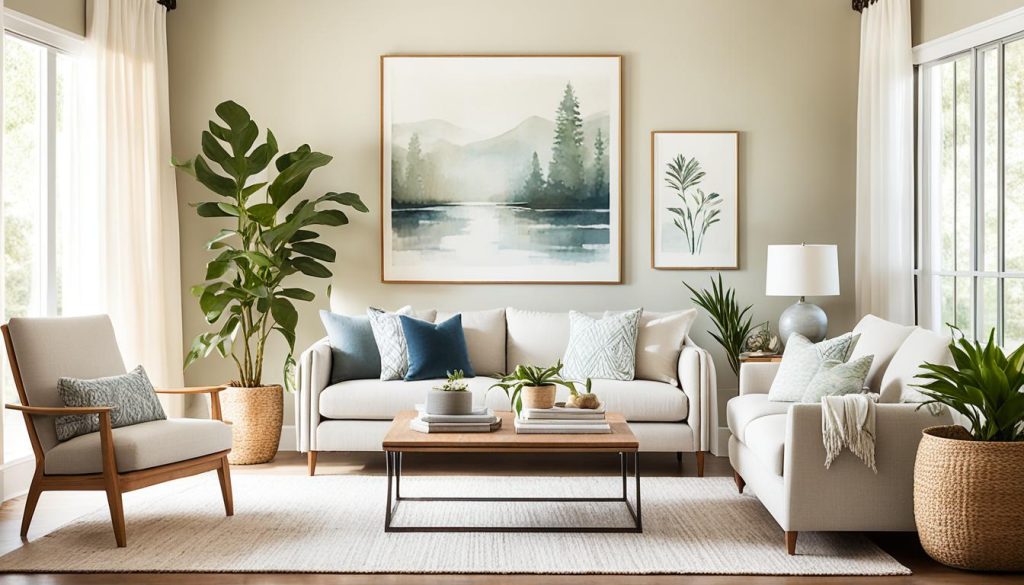
table {
width: 100%;
border-collapse: collapse;
}
th, td {
border: 1px solid #dddddd;
text-align: left;
padding: 8px;
}
th {
font-weight: bold;
}
| Decor Ideas | Description |
|---|---|
| Family Photographs | Display cherished family photographs that evoke feelings of warmth and nostalgia. |
| Religious Symbols | Incorporate symbols of your faith or spirituality to create a deeper sense of meaning. |
| Meaningful Objects | Display heirlooms or objects with sentimental value to bring comfort and positive emotions. |
| Artwork | Choose pieces of art that resonate with you on a personal and emotional level. |
| Furniture Arrangement | Create a space that encourages interaction and conversation by positioning furniture wisely. |
Simplify Your Life
Creating a restful and healing home environment doesn’t have to be complicated. In fact, simplifying your life can be a powerful way to reduce stress and create a sense of calm and peace. Here are a few strategies to help you declutter, clean, and create quiet spaces for reflection:
Decluttering
Clutter can contribute to feelings of overwhelm and anxiety. Take the time to declutter your home and remove the unnecessary items that are taking up space and causing visual and mental clutter. Start small by tackling one room or area at a time, and create a system for organizing and storing the items you choose to keep.
Cleaning Regularly
A clean environment can have a positive impact on your mental and physical well-being. Set aside time each week to clean your home, focusing on areas that tend to accumulate dust and dirt. Regular cleaning not only creates a healthier living space but also provides a sense of accomplishment and satisfaction.
Quiet Spaces for Reflection
In the midst of our busy lives, it’s important to set aside quiet spaces for reflection and relaxation. Find a corner in your home where you can create a peaceful retreat. This could be a cozy reading nook, a meditation area, or simply a comfortable chair by a window. Fill this space with items that bring you joy and promote relaxation, such as soft blankets, calming artwork, and a tabletop fountain.
By simplifying your life through decluttering, regular cleaning, and creating quiet spaces for reflection, you can reduce stress and create a calming environment that supports your overall well-being.
Choose the Right Colors
When creating a healing and restful home environment, color selection plays a crucial role. The psychology of color can significantly impact your mood and overall well-being. By choosing colors that align with your personality and desired atmosphere, you can create a harmonious space that promotes relaxation and rejuvenation.
Consider incorporating the following colors into different rooms of your home to evoke specific feelings:
- Reds, oranges, and yellows: These warm colors are known to energize and stimulate. Use them in areas where you want to promote creativity, such as a home office or art studio.
- Blues, greens, and violets: Cool colors like blues, greens, and violets have a calming effect on the mind and body. Incorporate these colors in spaces where you want to encourage peace and restfulness, such as the bedroom or a meditation corner.
Remember that color preferences can vary from person to person, so trust your intuition when selecting colors for your home. Experiment with different shades and combinations to find what resonates with you and your desired ambiance.
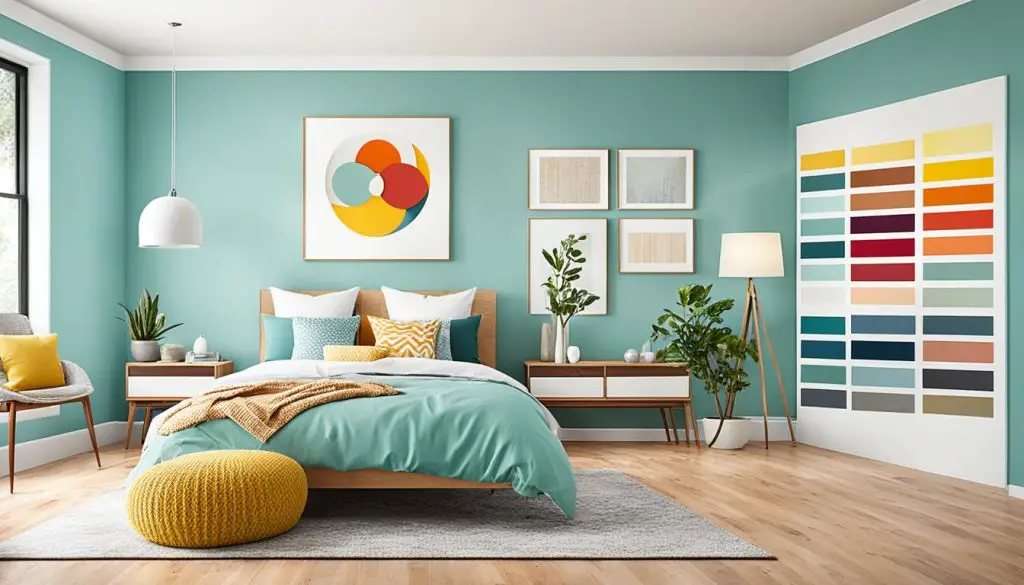
Visualize how the chosen colors will interact with the other elements in the room, such as furniture, artwork, and natural lighting. Aim for a cohesive and balanced color palette that enhances the overall healing environment.
Create a Relaxing Bedroom
Your bedroom should be a sanctuary for sleep and relaxation. It’s a space where you can escape from the chaos of the outside world and unwind. By creating a dark and clutter-free environment, you can transform your bedroom into a peaceful retreat that promotes restorative sleep and relaxation.
Here are some tips to help you create a relaxing bedroom:
- Use blackout shades: Install blackout shades or curtains to block out any unwanted light. Darkness promotes the production of melatonin, a hormone that helps regulate sleep.
- Eliminate or dim lights: Turn off or minimize artificial lighting in your bedroom, especially before bedtime. Use soft, dimmable lights or bedside lamps to create a cozy ambiance.
- Choose comfortable bedding: Invest in high-quality, comfortable bedding that feels luxurious against your skin. Opt for soft, breathable fabrics like cotton or bamboo to enhance your sleeping experience.
- Declutter the space: Remove any unnecessary items from your bedroom to create an organized and calming environment. Clutter can contribute to a sense of chaos and make it difficult to relax.
By implementing these changes, you can create a relaxing and restful atmosphere in your bedroom, making it a true sanctuary for sleep and rejuvenation.
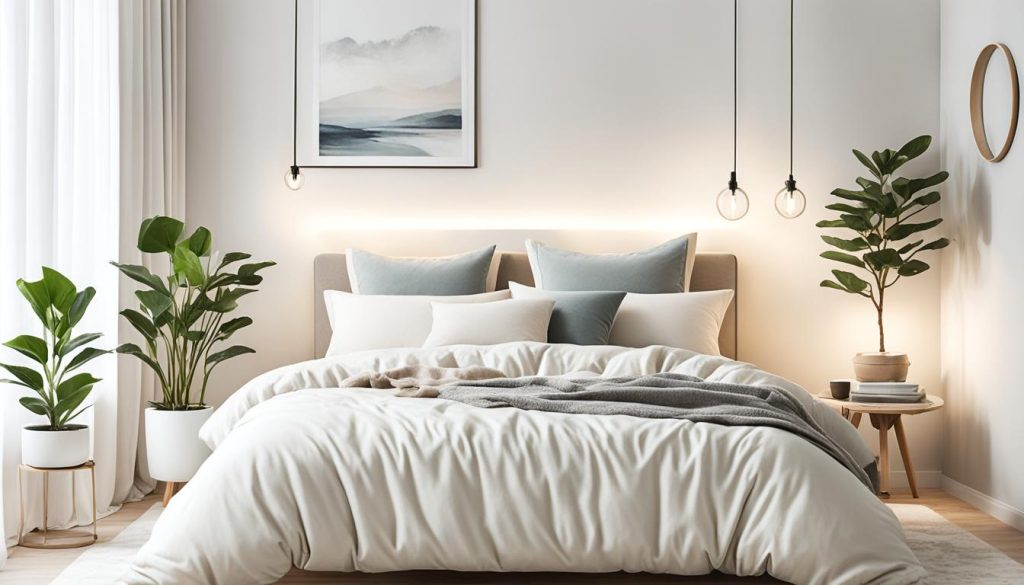
Benefits of a Relaxing Bedroom
- Promotes better sleep: A dark and clutter-free bedroom can help you fall asleep faster and improve the quality of your rest. Adequate sleep is crucial for overall health and well-being.
- Reduces stress and anxiety: A tranquil bedroom environment can have a calming effect on your mind and body, helping to alleviate stress and anxiety.
- Enhances relaxation: With the right ambiance, your bedroom can become a space where you can unwind, relax, and recharge after a long day.
- Creates a sanctuary: By transforming your bedroom into a relaxing retreat, you can have a designated space that is solely dedicated to rest and rejuvenation.
Remember, your bedroom should be a sanctuary for sleep and relaxation. By creating a dark and clutter-free environment, using blackout shades, investing in comfortable bedding, and decluttering the space, you can turn your bedroom into a calming and restorative haven.
Find Healing Spaces Outdoors
Creating a healing space indoors is important, but don’t forget to seek healing spaces outdoors as well. Connecting with nature has a profound impact on our well-being, offering a sense of tranquility and rejuvenation. Whether it’s a local park, a beach, or your own backyard, spending time in healing outdoor spaces can provide numerous benefits.
Take the time to watch the sunset and be amazed by the vibrant colors painting the sky. The calming hues and peaceful atmosphere can help you unwind and find inner peace. Watch the beauty unfold as the sun dips below the horizon, casting a warm glow that fills you with serenity.
Another way to experience healing outdoors is through the soothing sounds of a fountain. Listening to the gentle flow of water can help clear your mind and reduce stress. Allow the sounds of the fountain to wash away your worries and immerse yourself in the present moment.
Bird watching is also a wonderful way to connect with nature. Observe the graceful movements of birds as they flit from tree to tree, their melodies filling the air. Let the sights and sounds of the birds inspire you and bring a sense of joy to your heart.
Remember, healing outdoor spaces can be found everywhere. It’s about being mindful and appreciating the beauty that surrounds us. So go outside, breathe in the fresh air, and allow nature to heal and rejuvenate your body and soul.
Contribute to a Healthy Environment
Create a healthy environment not just for yourself, but for future generations. By taking small, conscious steps towards reducing your carbon footprint and embracing sustainable practices, you can make a meaningful impact on the planet. Here are some ways you can contribute to a healthier environment:
- Choose Chemical-Free Food: Support local farmers and opt for organic produce that is free from harmful pesticides and chemicals. By making this choice, you not only promote your own health but also contribute to a cleaner and healthier environment.
- Reduce Waste: Embrace a zero-waste lifestyle by minimizing the amount of waste you produce. Prioritize reusable products, such as shopping bags, water bottles, and food containers. Compost organic waste and recycle whenever possible.
- Recycle More: Properly separate and recycle your waste to reduce the amount of material that ends up in landfills. Educate yourself on local recycling guidelines and ensure that you are recycling effectively.
- Use Greener Cleaning and Laundry Materials: Ditch chemical-laden cleaners and opt for environmentally friendly alternatives. Look for products that are labeled as being biodegradable, non-toxic, and free from harmful chemicals.
By adopting these practices, you can create a healthier and more sustainable environment, benefiting not only your well-being but also the well-being of future generations.
Environmental Benefits of Waste Reduction
Waste reduction plays a crucial role in preserving our environment. By minimizing the amount of waste we produce, we can:
- Promote a clean and healthy ecosystem
- Reduce pollution of air, water, and land
- Conserve natural resources
- Decrease greenhouse gas emissions
- Limit the destruction of habitats and wildlife
By taking steps to reduce waste, you are contributing to the overall health and sustainability of our planet.
| Waste Reduction Methods | Environmental Benefits |
|---|---|
| Recycling | – Reduces the need for raw materials – Saves energy and reduces greenhouse gas emissions – Decreases the amount of waste sent to landfills |
| Composting | – Diverts organic waste from landfills – Creates nutrient-rich soil for gardening – Reduces the need for chemical fertilizers |
| Reusable Products | – Reduces single-use plastic waste – Decreases the demand for new materials – Limits the energy and resources used in production |
| Upcycling | – Gives new life to old items, minimizing waste – Reduces the consumption of new products – Sparks creativity and encourages sustainable practices |
By embracing waste reduction practices, you can make a positive impact on the environment and help create a healthier future for all.
Enhance Your Ability to Heal
Your healing journey involves more than just creating a physical healing environment in your home. To truly optimize your healing process, it’s important to focus on cultivating a supportive internal environment, nurturing strong interpersonal connections, and adopting healthy behaviors. By addressing these aspects of your life, you can enhance your ability to heal and promote overall well-being.
Cultivate a Positive Internal Environment
An optimal healing environment starts from within. Cultivating a positive and nurturing internal environment can have a profound effect on your healing journey. Here are a few ways to create a positive internal environment:
- Practice mindfulness and self-care: Engage in daily practices that promote self-reflection, relaxation, and stress reduction. This can include activities such as meditation, deep breathing exercises, journaling, or engaging in hobbies that bring you joy.
- Nourish your body: Prioritize a healthy diet that includes nutrient-rich foods, stay hydrated, and get regular exercise to support your physical well-being.
- Cultivate a positive mindset: Focus on positive affirmations, gratitude, and self-compassion. Surround yourself with uplifting and inspiring quotes or images that resonate with you.
Build a Strong Interpersonal Support System
Healing is not a solitary journey, and having a supportive network of family, friends, and healthcare professionals is crucial. Here are a few steps to build a strong interpersonal support system:
- Communicate your needs: Clearly express your needs to your loved ones and let them know how they can offer support. Open and honest communication fosters understanding and empathy.
- Seek professional guidance: Consult with healthcare providers who specialize in your specific healing journey. They can offer expert advice, guidance, and support tailored to your unique situation.
- Join support groups: Connect with others facing similar challenges through support groups or online communities. Sharing experiences and insights can provide valuable emotional support and a sense of belonging.
Adopt Healthy Behaviors
Your behaviors play a significant role in your overall well-being and healing process. Consider incorporating the following healthy habits into your daily routine:
- Get enough restful sleep: Establish a regular sleep schedule and create a relaxing bedroom environment that promotes quality sleep. Avoid electronic devices before bed and consider incorporating calming rituals, such as reading or listening to soft music.
- Engage in physical activity: Regular exercise can boost your energy levels, reduce stress, and improve your overall mood. Find activities that you enjoy and incorporate them into your routine.
- Practice self-care: Take time for self-care activities that rejuvenate and recharge you. This can include activities such as taking a bath, engaging in a hobby, or practicing relaxation techniques.
The body-mind-spirit connection plays a vital role in your ability to heal. By nurturing your internal environment, building a strong support system, and adopting healthy behaviors, you can create an optimal healing environment that supports your overall well-being. Remember, your healing journey is unique to you, so embrace the practices and strategies that resonate with your needs and preferences.
Pay Attention to the Details
In creating a healing environment at home, it’s the small changes that can make a big impact on your well-being. Paying attention to the details helps to create a calming atmosphere that supports your overall health and happiness.
Start by turning off electronics, especially in the evening. The blue light emitted by screens can disrupt your sleep patterns and prevent you from fully relaxing. Instead, opt for quiet evenings with calming music that helps you unwind and destress. Let the soothing melodies wash away the worries of the day and promote a sense of tranquility.
Another important aspect of creating a healing space is scent selection. Choose scents that have a calming effect, such as lavender or chamomile, and incorporate them into your home environment. Consider using essential oils, candles, or potpourri to infuse your surroundings with these soothing fragrances. The subtle scent in the air can have a profound impact on your mood and overall sense of well-being.
By focusing on these seemingly small details, you can enhance the overall healing environment of your home. So, take a moment to turn off those devices, play some calming music, and fill the air with soothing scents. These simple changes can have a powerful effect on your daily life, promoting a sense of peace and relaxation.
